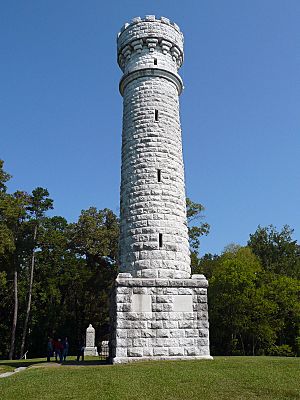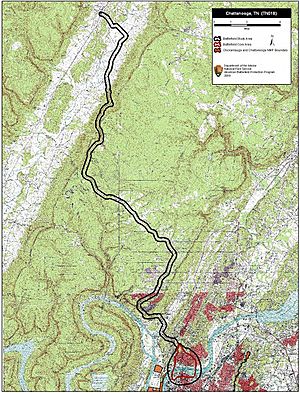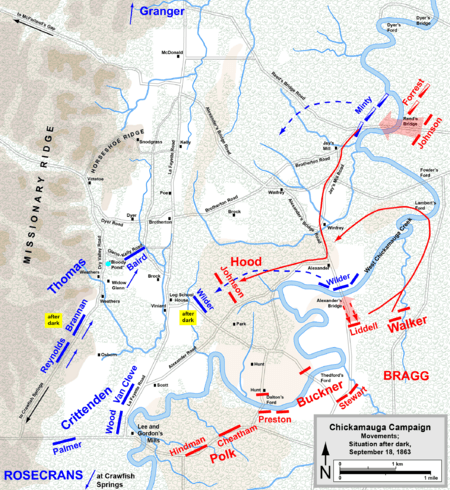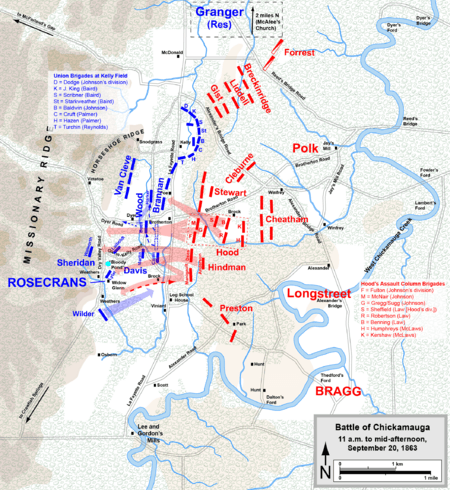Lightning Brigade facts for kids
Quick facts for kids Lightning Brigade |
|
|---|---|

Wilder Brigade Monument at Chickamauga and Chattanooga National Military Park
|
|
| Active | February 1863 – November 1863 |
| Country | |
| Allegiance | Union |
| Branch | Union Army |
| Type | Mounted Infantry |
| Size | Five regiments and one battery:
|
| Nickname(s) | Lightning Brigade Hatchet Brigade |
| Equipment | Spencer repeating rifle |
| Engagements | American Civil War |
| Commanders | |
| Notable commanders |
Col. John T. Wilder |
The Lightning Brigade, also known as Wilder's Brigade or the Hatchet Brigade, was a special unit in the Union Army during the American Civil War. It was formed in March 1863 and lasted until November 1863. This brigade was unique because its soldiers were mounted infantry. This meant they rode horses or mules to move quickly, but then fought on foot like regular infantry.
The brigade was part of the Army of the Cumberland and was led by Colonel John T. Wilder. Even though it was officially part of a larger division, it often worked on its own. Its main job was to move fast and support any part of the army that needed help.
The brigade included soldiers from:
- 92nd Illinois Mounted Infantry
- 98th Illinois Mounted Infantry
- 123rd Illinois Mounted Infantry
- 17th Indiana Mounted Infantry
- 72nd Indiana Mounted Infantry
- 18th Independent Battery Indiana Light Artillery (an artillery unit)
Contents
How the Lightning Brigade Was Formed
In 1862, the Union Army faced a big problem. Confederate cavalry and small groups of fighters were causing a lot of trouble. They were fast and hard to catch. Union generals, like Major General William Rosecrans, realized they needed their own fast-moving troops.
They tried different ideas. Once, a brigade (including John T. Wilder's regiment) used mule wagons to chase Confederate raiders. They almost caught them, but the Confederates were still too fast. This showed that regular infantry, even with wagons, couldn't keep up with cavalry.
General Rosecrans decided the army needed "mounted infantry." These soldiers would ride to battles but fight on foot. This was like the old "dragoon" soldiers. Rosecrans asked for permission to get enough horses or mules for 5,000 mounted infantry. He also wanted them to have better weapons.
Becoming Mounted Infantry
Colonel Wilder was very excited about the idea of mounted infantry. In February 1863, Rosecrans allowed Wilder to turn his brigade into a mounted unit. Most of the regiments in the brigade voted to become mounted infantry.
Wilder found about a thousand mules for his soldiers to ride. He didn't get them from the government. Instead, his men found them in the countryside. Later, they often took horses from local areas and used them instead of mules. Wilder was proud that it "did not cost the Government one dollar to mount my men."
The brigade's soldiers would ride quickly to where they needed to be. Then, they would get off their mounts and fight. This speed earned them the nickname "The Lightning Brigade." They were also called the "Hatchet Brigade" because they carried long-handled hatchets instead of the usual cavalry swords.
Wilder also wanted his men to have better guns. He thought the standard muzzle-loaded rifles were too slow to reload. He wanted repeating rifles, which could fire many shots quickly. After seeing a demonstration, Wilder chose the Spencer repeating rifle. This rifle could fire seven shots without reloading. It was much faster than other rifles used in the Civil War.
With their new mounts and powerful rifles, the Lightning Brigade developed new ways of fighting. They trained through May and June 1863. By mid-June, the soldiers knew how strong their new rifles were. They felt very confident in their skills and their new weapons. Wilder always reminded his men that they were infantry who rode, not cavalry.
Tullahoma Campaign
Battle of Hoover's Gap
In June 1863, General Rosecrans began a campaign to push the Confederates out of Tennessee. On June 24, in heavy rain, the Lightning Brigade led the way towards Hoover's Gap. They moved so fast that they reached the gap almost nine miles ahead of the main army.
Wilder's commander told him to wait for the rest of the infantry, but Wilder decided to take and hold the gap. His brigade surprised Confederate cavalry and drove them back. The Confederates failed to report the Union advance, which was a big mistake for them.
Wilder's men faced a much larger Confederate force. They dug in on the hills and held their ground. The Confederates attacked, but the Lightning Brigade's Spencer repeating rifles fired so many shots that the Confederates were driven back with heavy losses. One soldier wrote about how the Spencers fired "another and another and another without cessation."
After a long day of fighting, the main Union army arrived. General George Henry Thomas shook Wilder's hand and told him, "You have saved the lives of a thousand men by your gallant conduct today." Rosecrans also praised Wilder, saying that if he had retreated, it would have cost thousands of lives to take the position later.
The Lightning Brigade's success at Hoover's Gap showed how effective mounted infantry with repeating rifles could be.
The Manchester Raid
On June 27, the Lightning Brigade reached Manchester. Two days later, they went on a daring raid behind Confederate lines. Their goal was to destroy railroad tracks that supplied the Confederate army.
They faced a swollen river, but they cleverly took apart a nearby mill and used the wood to build a raft. They floated their cannons across the river. They defeated a small group of Confederates, tore up railroad tracks, and burned a supply depot. The next morning, they destroyed another rail line. Even though a larger Confederate force chased them, the Lightning Brigade returned to Manchester without losing a single man.
This raid showed how fast and effective the brigade was. Because of their success, the brigade was often allowed to operate independently, acting as a fast-moving reserve for the entire army.
Chickamauga Campaign
The Lightning Brigade continued to be a key unit in the Chickamauga Campaign. They were often given important missions because of their speed and firepower.
Second Battle of Chattanooga
(August 21 – September 8, 1863)
After pushing the Confederates out of middle Tennessee, the Union Army wanted to capture Chattanooga, Tennessee. General Rosecrans planned to trick the Confederates. He sent the Lightning Brigade and other units to the north side of the Tennessee River, opposite Chattanooga. Their job was to make a lot of noise and pretend they were going to cross the river there. This would keep the Confederate army focused on the north, while the main Union army crossed the river far to the west and south.
On August 21, the Lightning Brigade began its deception. They shelled Chattanooga from the north bank, sinking two Confederate steamers. They moved around a lot to confuse the Confederates. They even faked building boats by hammering and sawing wood, then throwing pieces into the river so they would float downstream to Chattanooga. At night, they built many campfires to make it look like there were huge numbers of Union troops.
This trick worked perfectly. Confederate General Braxton Bragg kept his attention on the north side of the river. Meanwhile, the main Union army crossed the river safely to the west and south. When Bragg finally realized what was happening on September 8, he had to quickly abandon Chattanooga and retreat into Georgia.
Skirmish at Ringgold
(September 11–12, 1863)
As the Union army moved south, its different parts became spread out. On September 11, the Lightning Brigade advanced to Ringgold, Georgia. They fought and defeated some Confederate cavalry and other troops. They returned to their main lines that night.
The next morning, they were ordered back to Ringgold. Four miles from the town, they ran into more Confederates. After pushing them back, Wilder found that a larger Confederate force had cut off his way back. The Lightning Brigade was surrounded!
Wilder used a clever trick. At night, he had his men spread out their campfires over a large area. This made the Confederates think his force was much bigger than it was. While the Confederates waited for morning to attack, Wilder sent one regiment to find an escape route. Once they found one, the entire brigade quietly slipped away in the dark, without losing a single man. The next morning, the Confederates attacked the empty camp.
Battle of Chickamauga
(September 19–20, 1863)
First Day of Battle
On September 17, the Lightning Brigade was sent to defend Alexander's Bridge over the Chickamauga Creek. The next day, September 18, they blocked the crossing against a Confederate attack. Using their Spencer repeating rifles and Captain Lilly's cannons, they held off a Confederate brigade, causing many casualties. The Confederates had to find another crossing point, which slowed them down a lot.
On September 19, the main battle began. The Lightning Brigade was held in reserve. In the afternoon, a Confederate attack pushed back a Union division. Wilder's brigade was sent forward. They quickly broke up a Confederate attack, firing so many shots that the Confederates suffered heavy losses and had to retreat.
Later, another Confederate attack threatened to break through the Union lines near the Glenn Cabin, where General Rosecrans had his headquarters. The Lightning Brigade was sent in again. They waited until the Confederates were very close, then opened fire with their Spencers. The massive firepower drove the Confederates into a ditch, where Lilly's cannons fired deadly "canister" shots (like giant shotgun blasts). The Confederates were forced to retreat. The Lightning Brigade had saved that part of the Union line.
Second Day of Battle
On September 20, the battle continued. A huge Confederate attack broke through the Union center, causing many Union soldiers to run away. The Lightning Brigade was ordered to counterattack.
They charged forward, surprising the Confederates with their rapid fire. The Spencers and Lilly's cannons stopped the Confederate advance cold. Wilder's men routed one Confederate regiment and forced another to fall back. They even captured 200 prisoners. The brigade had stopped a major Confederate breakthrough.
Wilder wanted to attack the flank of the Confederate column and help the rest of the Union army. However, a government official, Charles Anderson Dana, arrived and told Wilder that the battle was lost. Dana demanded an escort to Chattanooga. While Wilder arranged this, the chance for a big attack was lost. Wilder then ordered his men to retreat.
The Lightning Brigade was one of the few Union units that fought well and stayed organized during the chaos of the battle. They left the field in good order, proving the power of their unique weapons and tactics.
What Happened Next
After the Battle of Chickamauga, the Union army retreated to Chattanooga. The Confederates surrounded the city, starting a siege.
The Union army was reorganized. General Ulysses S. Grant took command of all Union forces in the region. In October, the Lightning Brigade was gradually broken up. Its regiments were moved into the army's regular cavalry units. The 92nd Illinois was used for guarding supply lines and escorting commanders. The Lightning Brigade, as a single, unique unit, was no longer together.






